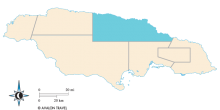Jamaica's Maroons date back to the Spanish settlement of the island, when it came to be accepted that a fraction of the blacks brought from Africa as slaves would not succumb to live in perpetual subordination and would instead resist perpetually until granted their freedom. These so-called "runaway slaves" were termed "Cimarrones" by the Spaniards, a name later translated into English as Maroon. To name these warriors "runaway slaves" is to diminish the fact that not only did they flee the plantation, but they also beat into the most remote and mountainous regions of the island to claim land and hold it against assault. The Spaniards ultimately gave up in their attempt at putting down the Maroons, many of whom it is said descended from the warrior Ashanti people of West Africa. The British would also eventually sign a peace treaty with the Maroons in 1738, the legacy of which has left the Maroons with their sovereignty to this day. The Maroon treaty was signed by Cudjoe (Kojo), whose repeated defeat of British forces led to granting the Maroons privilege to large swaths of Jamaica's highlands. Large Maroon settlements grew in Accompong, St. Elizabeth, as well as in Moore Town in the Rio Grande River Valley, and above Buff Bay in Charles Town, Portland, and in Scott's Hall, St. Mary. Today the Maroons are still a force to be courted by those representatives of government who have Maroon lands within their constituencies. While the communities themselves have been largely diluted since emancipation, the warrior spirit of the Maroons has permeated Jamaican society at large, influencing social movements like the Rastafarians, who draw on their experience as rebels against the status quo to present an alternate worldview based on principles that can be traced through the Maroon heritage to Africa.
Call or email for assistance planning your trip: +1 (212) 203-0064 | reservations@moonjamaica.com

